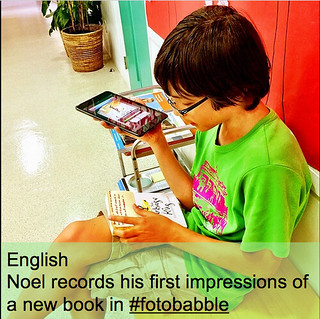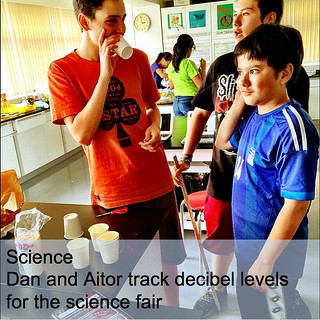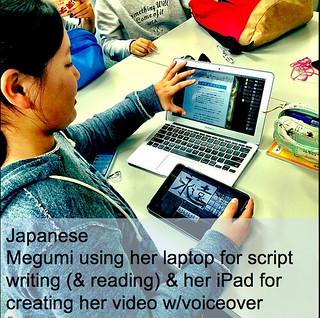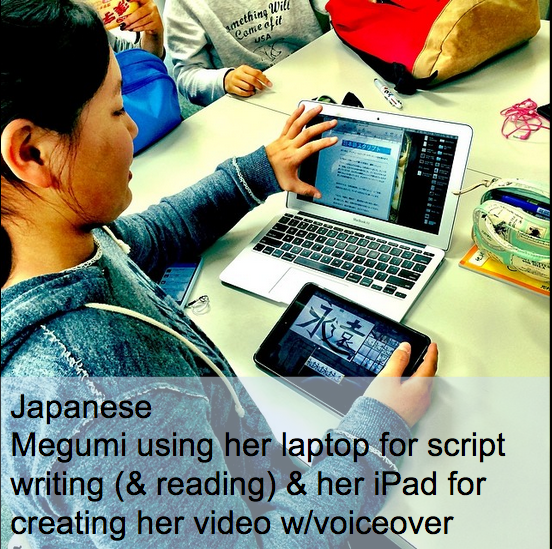During the month of May our grade 7 students trialed the use of 2 (yes 2!) school issued devices: an iPad Mini and a MacBook Air 11″. This trial is an evolution of our existing Connected Learning Community (1:1 program) – read more about the development of our 2:1 trial on my previous posts.
2:1 Learning in Action
As part of the trial, Clint and I visited as many classrooms as we could to see how the students and teachers were using both devices. As part of our conversations with students, parents and teachers in preparation for the trial, we talked about a number of key themes and it was amazing to see those (and more) in action as we visited classrooms.
Here are a few highlights:
Complementary Devices
 One of the reasons why were are using two devices (rather than continuing as we are with laptops or making a switch to iPads) is that we feel the devices when used together are complementary – while the iPad is good for mobile and interactive learning, the laptops is great for heavy duty typing and multimedia creation. Using them both together gets the best out of both devices – many of the teachers and parents already have this experience with our laptops and our phones, but, not every student has a smart phone at YIS (yet!).
One of the reasons why were are using two devices (rather than continuing as we are with laptops or making a switch to iPads) is that we feel the devices when used together are complementary – while the iPad is good for mobile and interactive learning, the laptops is great for heavy duty typing and multimedia creation. Using them both together gets the best out of both devices – many of the teachers and parents already have this experience with our laptops and our phones, but, not every student has a smart phone at YIS (yet!).
As we visited classrooms, we saw lots of students using both devices, each for the most appropriate purpose, including:
- recording on the iPad (prioritizing mobility and appropriate locations) and editing on the laptop
- using the iPad as a second screen – editing a script on the laptop while the prezi is open on the iPad, for example
- using the iPad for handwriting input (like kanji) and then bringing it to the laptop to include in other elements
This concept came up in the student feedback as well:
- “We were able to do two things at once like reading off a script on the iPad and recording on the computer.”
- “I think that the highlight was being able to have two things at once so that you can research and type out. It also makes it easier for you to read books. Also when doing a speech, speaker notes were easier rather than paper.”
- “Using an iPad helped me do things easier and quicker than I could have done them on my laptop. But also, since they are complementary devices, they were both good to use. Using our iPad instead of computers in some occasions made our projects in class more fun and efficient.”
- “One of the best parts of having both the iPad and my laptop with me was that I could watch videos or record for school, at the same time that I record or read information from my laptop. I also found it much more convenient to record on the iPad then struggle using the Photo Booth Application on the laptop.”
Mobile Learning
 Although we are extremely fortunate to have laptops already, one of the things we notice quite a bit when walking in the hallways is students using the laptops for filming and audio recording – often carrying around their laptops open to use the built-in camera. It’s great to see that our students are problem solvers, but we try to emphasize safety and responsibility with the laptops, and the video and audio recording quality on the laptop is not that great.
Although we are extremely fortunate to have laptops already, one of the things we notice quite a bit when walking in the hallways is students using the laptops for filming and audio recording – often carrying around their laptops open to use the built-in camera. It’s great to see that our students are problem solvers, but we try to emphasize safety and responsibility with the laptops, and the video and audio recording quality on the laptop is not that great.
So, as we expected, when we visited classrooms, we saw tons of multimedia recording including:
- audio voiceovers for movies
- capturing still images and video as needed for a variety of tasks
- the use of apps like Photobabble for voice over image recording
Of course this experience was definitely not confined to just the classrooms. During the trial we had a grade 7 field trip where groups of students were exploring Yokohama, capturing all sorts of multimedia on their iPads throughout the day.
Mobility was one of the key features that students and parents were looking for in this trial as well. During our Community Focus Group meetings, students mentioned that they struggle to use their laptops on the train because it’s so unusual here in Japan, having an iPad has allowed them to be more productive during transportation time (depending on where they live, our students can travel up to an hour back and forth from school) than they would ordinarily be.
On the parent survey, they also highlighted this advantage:
- “It was effective for my daughter to quickly research some materials on the internet. My daughter preferred using her PC for her homework and other works. She tried to utilize using her iPad on the train while commuting.”
Creativity & Student Choice
 One of our goals for the trial was to encourage and promote student creativity and individual choice. We wanted to give students as many different ways as possible to demonstrate their learning and express themselves. Although we only had the iPads for a three-week trial, we saw students experimenting with their iPad and laptop in lots of different ways, some that we expected, others that we didn’t, including:
One of our goals for the trial was to encourage and promote student creativity and individual choice. We wanted to give students as many different ways as possible to demonstrate their learning and express themselves. Although we only had the iPads for a three-week trial, we saw students experimenting with their iPad and laptop in lots of different ways, some that we expected, others that we didn’t, including:
- downloading very specific apps for subject-based projects – for example a decibel calculator for the science fair
- presenting work in different formats, selected by the student
- finding new and unique ways to do things that we anticipated would be done using our Top 10 Apps
- absolutely seamless ways to share their learning with others – both within the class and beyond
Overall, this was the most commonly agreed upon success of our trial. Parents, students and teachers all highlighted how well the iPad enhanced student creativity and choice:
- We had a choice of what to do. We didn’t only have to use the computer we could be unique from other people and have a different style. It’s also more exciting to choose which tool you want to use. Holding something and actually feeling is better. Another reason why it’s better is because if you forget your computer or iPad you always have a small back up.” (student)
- “The best parts of having an iPad was the choice of which apps to use for assessments and the ability to present in different ways than usual.” (student)
- “It seems a bit ineffective since opening and working with the different apps and technology takes a bit more time compared to working from a book or direct instruction but it makes the learning more fun so that gains a whole lot. The students were motivated to work with the iPads and making videos, recording and sharing in a quick way was effective and fun.” (teacher)
- “I think it was a great experience for my daughter and a definitely useful tool for her learning. We’re thankful to be a part of this initial trial and we hope for its launch in the near future.” (parent)
Interactive
 One of the issues we have with laptops is that they are not quite as interactive as we want them to be. The natural input of just writing on the screen, and the ability to combine handwriting with typed text as well as over images and video is something teachers have been asking to take advantage of for several years. Having access to both devices for this trial really supported those kinds of kinesthetic interactions, like:
One of the issues we have with laptops is that they are not quite as interactive as we want them to be. The natural input of just writing on the screen, and the ability to combine handwriting with typed text as well as over images and video is something teachers have been asking to take advantage of for several years. Having access to both devices for this trial really supported those kinds of kinesthetic interactions, like:
- using Coaches Eye to track and improve physical performance in PE
- transitioning from handwritten complex equations to typed in math
- highlighting and labeling experiments in Explain Everything in science
Thanks to Alex Thomas, one of our superstar PE teachers for this insight into the PE classroom with iPads:
Looking Ahead
Although the feedback from the trial was very positive, from students, parents and teachers, alike, we still have more work to do. Next year we will continue with the trial, but with a new group of students – next year’s grade 7. Having a shorter trial this year allowed us to really understand the dynamics of two devices in the classroom and at home, as well as help us uncover areas that we need to focus on for next year.
 Based on the feedback surveys, we’ll be focusing on:
Based on the feedback surveys, we’ll be focusing on:
Managing time & distractions: As the surveys highlighted, students are well prepared to focus on learning during school time, but struggle to manage this challenge at home. Focusing on this element during our iPad Institute and in each class, as well as further supporting parents, will be a key element of our program for next year.
Complimentary Devices: Having the iPads for only three weeks this semester made it more challenging to try to use each device in the most effective way. Next year we can highlight the different ways to make the most out of both devices, without feeling pressure to try everything in a limited timeframe. Getting to know a new tool always takes time, which we will have over the course of the next school year.
Balance: As always, we will continue to work towards helping students (and teachers, and parents!) find balance in their use of screen time. Over the course of the year next year we can continue to reflect on this process and see which strategies and approaches work best for all stakeholders.
Does your school provide multiple devices to your students? If so, what are some strategies you use to support the themes above?






Thank you for writing this piece…..the use (and abuse) of tech in the classroom is something we’re struggling with more and more in our school. Some teachers want to respond to this by severely limiting it or by getting rid of it all together. I love your focus on the importance of student choice and the need to teach balance.
Carla Meyrink´s last blog post ..The Praise Problem
Hi Kim,
Totally awesome, reading your blog posts. Using two devices at once, exploring prezi, are all things I want to do more of as my school is becoming an apple school. I’m still on the lookout for specific ipad apps for ESL purposes, too, especially grammar apps with engaging visuals for upper elementary students. If you know of any, please drop me a line.
Thanks,
Silke
Silke Trester´s last blog post ..Infographic CV: On the Move!